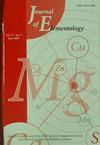Effects of copper stress on morphological traits and copper compartmentalization and microstructure of flax (Linum usitatissimum L.) cultivars
IF 0.7
4区 环境科学与生态学
Q4 ENVIRONMENTAL SCIENCES
引用次数: 0
Abstract
Flax ( Linum usitatissimum L.) is a crop plant that has long been used for various purposes, including production of fiber, oil, and food. In addition, it has more recently been studied for its phytoremediation potential to remove and detoxify environmental contaminants. Copper is a heavy metal that can be toxic to plants. In recent years, flax has begun to be used as a phytoremediation tool for phytoextraction of different heavy metals, especially when grown in metal-contaminated soils. The objective of the study was to conduct the efficiency of flax as a phytoremediation plant grown on the soil contaminated with different doses of copper (Cu) (control, 100 and 200 mg L -1 ) metal. The results revealed that a high concentrations of Cu in the soil negatively affected plant growth and development by reducing plant height (30.17-22.33 cm), technical stem length (25.83-18.33 cm) and root length (7.50-4.00 cm) compared with the control (30.17-25.17 cm). The content of Cu in the leaves, stems and roots of flax cultivars was higher at 200 mg L -1 Cu concentration in the Mures and Erkendorfi cultivars. In addition, the two Cu concentrations (100 and 200 mg L -1 ) were highly destructive to the plant, according to the SEM images, and the maximum stem damage was reported. Thus, the soil Cu content should be carefully controlled in order to avoid adverse effects on plant growth and development. Consequently, future research is needed for gaining better understanding of the physiology, biochemistry, anatomy, and molecular biology of flax in order to increase its pollutant removal efficiency.铜胁迫对亚麻(Linum usitatissimum L.)品种形态性状及铜区隔和微观结构的影响
本文章由计算机程序翻译,如有差异,请以英文原文为准。
求助全文
约1分钟内获得全文
求助全文
来源期刊

Journal of Elementology
ENVIRONMENTAL SCIENCES-
CiteScore
1.80
自引率
12.50%
发文量
15
审稿时长
6-12 weeks
期刊介绍:
The Jorunal of Elementology contains original, experimental and review papers pertaining to the transformations of organic and mineral compounds. The research problems encompass organic and mineral compounds discussed from the angle of physiology, biochemistry and genetics; complex analyses and assessment of the conditions underlying biogeochemical cycles, symptoms of deficiencies and excess of chemical elements as well as their antagonistic and synergistic interactions. The papers published in the journal discusses problems from the fields of medical and health sciences, forestry, veterinary medicine, natural sciences and chemical sciences.
 求助内容:
求助内容: 应助结果提醒方式:
应助结果提醒方式:


